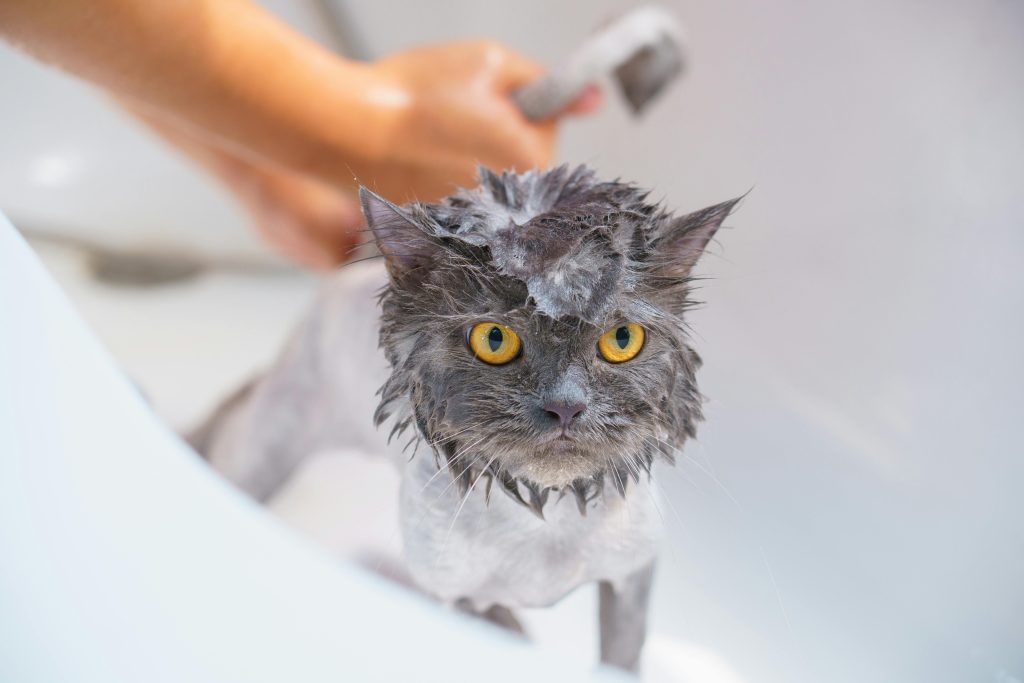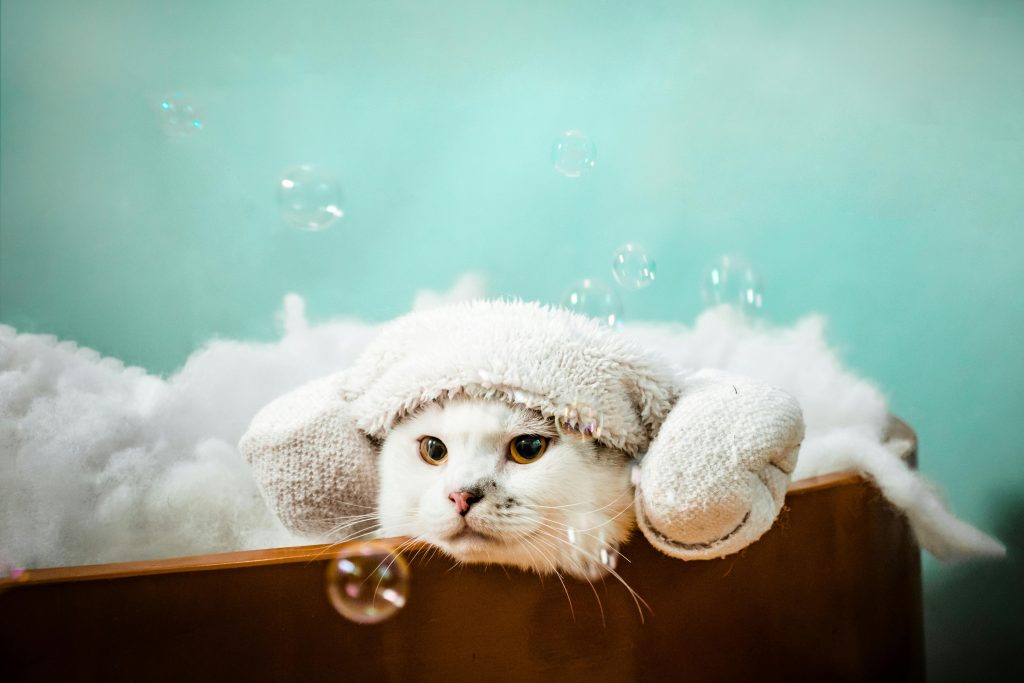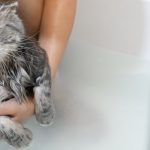Table of Contents
If you are without cat shampoo, don’t fret, several household items can be a safe substitute for keeping your feline’s fur clean. From baby shampoo to baking soda, you can choose from various alternatives that are gentle on your cat’s skin and effective in cleaning. Understanding your cat’s specific needs and sensitivities is essential to ensure a pleasant and safe bathing experience for them.
Discover the various options you can employ to maintain your cat’s hygiene and keep their coat shiny and healthy. Read on to learn about safe alternatives to cat shampoo and how to implement them properly. Don’t miss the essential tips and tricks that make bath time a breeze. Continue exploring to ensure your kitty stays clean and happy, even when you’re out of their regular shampoo.
Understanding the Need for Cat Bathing
While cats are known for their meticulous self-cleaning habits, there are situations where a bath becomes necessary. Bathing can help remove substances a cat cannot clean off, like sticky or toxic materials. It also assists in managing certain skin conditions or reducing allergens for sensitive humans. Understanding when and how to bathe your cat is crucial for their health and well-being.
When Is a Bath Necessary for Cats?
Baths are generally needed for cats when they become filthy or have gotten into something harmful that they cannot groom themselves. Outdoor cats, those with long hair, and cats with medical conditions that affect their ability to groom themselves may require more frequent bathing. A bath can also help remove fleas or treat specific skin conditions.
Risks of Overbathing and How to Avoid Them
Overbathing can strip away natural oils from your cat’s fur, leading to dry skin and irritation. To avoid these risks, limit baths to when necessary and always use a mild, cat-appropriate cleanser. Ensuring the bathing process is quick, and your cat is dried thoroughly can minimize stress and prevent chills.

Safe and Easy Alternatives to Cat Shampoo
In the absence of specialized cat shampoo, there are several safe and easy options. Always choose alternatives that are gentle and free of heavy fragrances or chemicals.
1. Baby Shampoo: A Gentle Substitute
Baby shampoo can be a gentle substitute for cat shampoo due to its mild formulation designed not to irritate your cat’s eyes. Look for a “no tears” formula to ensure it’s as gentle as possible, and dilute it with water to make it milder. Use sparingly and rinse thoroughly to prevent any residue that could irritate.
2. Baking Soda: A Natural Deodorizer
Baking soda is a natural deodorizer that freshens your cat’s coat between baths. It’s gentle enough for cats and can help absorb odors without washing a cat with water. Simply sprinkle a small amount onto the fur, massage it in gently, and then brush it out thoroughly.
3. DIY Oatmeal Shampoo: Soothing and Itch-Relief
A homemade oatmeal shampoo can soothe your cat’s fur and skin, especially if they have allergies or irritations. Grind plain oatmeal into a fine powder, mix with water to create a paste, and gently work it into your cat’s fur. Oatmeal’s natural properties can help to calm itchy skin and moisturize dry patches.
4. Dawn Dish Soap: For Oil and Grease
In cases of oil or grease on your cat’s coat, Dawn dish soap can be a safe and effective cleaner. It’s essential to use only a small amount and to rinse your cat’s fur thoroughly afterward. Dawn is used to clean wildlife safely, so in a pinch, it can also serve as a temporary solution for your feline.
5. Pet Wipes: Quick and Convenient Cleanup
Pet wipes can be an excellent option for a quick and convenient cleanup. They’re designed to be gentle and not irritate your cat’s skin, making them perfect for spot cleaning or for a cat that dislikes water. Pet wipes can help remove dirt and dander without needing a full bath.
6. DIY Dry Shampoo: Waterless Cleaning Option
Creating a DIY dry shampoo using cornstarch or baking soda can be a waterless cleaning option for your cat. Rub the powder gently into the cat’s fur, let it sit for a few minutes to absorb dirt and oils, and then brush it thoroughly. This method can freshen up your cat’s coat without the stress of a traditional bath.
7. Cornstarch: A Simple Detangling Solution
Cornstarch isn’t just for thickening sauces—it’s also a simple detangling solution for your cat’s fur. It can help loosen knots and make brushing more accessible, particularly useful for long-haired breeds. Work the cornstarch through the tangles and brush carefully to avoid pulling and causing discomfort.
Bathing Your Feline Friend Step-By-Step
Bathing your cat doesn’t have to be a daunting task. With the proper preparation and a gentle approach, you can ensure a stress-free experience for you and your pet. From gathering supplies to choosing the right time, a little planning goes a long way in making bath time successful.
Preparing Your Cat and the Bathing Area
Before introducing your cat to the water, preparing your pet and the bathing area is essential. Ensure the room is warm and free from drafts, fill the tub with a few inches of lukewarm water, and have your cleaning supplies within easy reach. Acclimating your cat to the space and the idea of bath time can also help reduce anxiety.
The Actual Bathing Process
The bathing process should be quick and efficient to minimize stress for your cat. Gently wet your cat’s fur, apply the chosen cleaning solution, and massage it in with care. Remember to avoid the face and ears and to rinse thoroughly to prevent any residue that could irritate your cat’s skin. Wrap your cat in a towel immediately after to keep them warm while they dry.

Precautions and Products to Avoid
When caring for a cat’s fur, avoiding products that may harm them is crucial. Certain substances can cause irritation or allergic reactions on sensitive feline skin. These include essential oils, such as tea tree oil, which can be toxic, and human personal care products that contain artificial fragrances and dyes. Additionally, avoid any cleaning products not specifically designed for pets, as these can strip natural oils from their skin and fur, leading to dryness and irritation.
Harmful Substances That Can Irritate Your Cat’s Skin
Not all products are safe for use on cats. Ingredients like alcohol, bleach, and ammonia, commonly found in household cleaners, can be dangerous if they come into contact with a cat’s skin. Even some flea treatments contain harsh chemicals that might cause adverse reactions. It’s best to consult a veterinarian before using any new product on your cat. When in doubt, opting for mild pet wipes or a little Dawn dish soap diluted in water can help keep them clean without the risk of irritation.
Why Human Shampoo Is Not Safe for Cats
Human shampoo is formulated for the pH balance of human skin, which differs from that of cats. Using human shampoo on a cat can lead to skin irritation, dryness, or even allergic reactions. Cats have a unique acid mantle that protects their skin from bacteria and viruses; when disrupted by-products not designed for them, it can cause health issues. To ensure the well-being of your feline friend, stick to products made for cats or gentle substitutes like baby shampoo when you’re out of cat-specific options.
Key Takeaways for Feline Hygiene Without Cat Shampoo
Several safe and effective alternatives make maintaining your cat’s hygiene without cat shampoo possible. Baby shampoo can be a gentle substitute, while natural deodorizers like baking soda help eliminate odors.
For cats with sensitive skin, a DIY oatmeal shampoo can provide soothing relief. A small amount of Dawn dish soap can be used cautiously when in contact with oil or grease. Between baths, pet wipes offer a quick way to clean your cat, and cornstarch can be used to detangle fur and freshen up their coat. Always remember to proceed with care, avoiding overbathing and staying mindful of products that could harm your feline friend.

Hi, I’m Zoey, a devoted mom to two charming Siamese cats. My passion lies in assisting fellow pet owners in providing optimal care for their cats. On CatsEuphoria, I share practical tips and relatable stories, inviting you to join me in appreciating the authentic bond between humans and our beloved feline companions.




